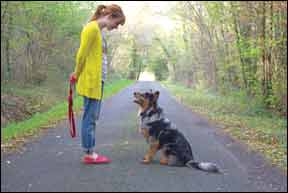We can’t possibly answer every question we receive about dog training or behavior. But we’ll try to answer some of the questions sent to us by subscribers, some of the time. The following are a few letters regarding issues that are common to many dogs and dog owners. If you’d like to submit a question about dog training or behavior, send it to WDJEditor@gmail.com.
I love Whole Dog Journal and have implemented many of your techniques and suggestions with our dog, Izzy. I hope that you may be able to further help us with her issue.

288
Izzy is a wonderful 31/2-year-old Australian Shepherd/Border Collie-mix. She’s super smart and well-trained, with lots of energy and a constant need for learning and exercise. In the last couple years, however, her aggressive moments have gotten to be a problem (I’m guessing it’s a protective instinct). She barks (like a yell) and confronts people in the following situations, ranked from most common to least:
1. Knock at the door of our house.
2. Someone gets close to our car (while parked).
3. If someone tries to pet her if she’s tied up (outside a store for instance, but we don’t do this at all anymore).
4. If someone appears after there has been an absence of other humans (at night or on a trail with few people).
I would chalk it up to the breed, protecting her herd (us), but I also need to do something about it.
We have started to ask her to “go to bed” when someone is at the door. It helps, but once she’s released she goes straight for the guest, barking and air-nipping (no contact) if they turn around. It’s embarrassing and uncomfortable; you don’t want to yell at your dog when friends come over and you also want to greet them face-to-face!
– Alan Stuart, Los Angeles
Pat Miller responds:
You are right to be concerned about Izzy’s behavior, especially the nipping at people. In these days of heightened sensitivity to canine behavior, it doesn’t take much for a dog to be designated as “potentially dangerous” or “dangerous” by your local animal control agency.
In some jurisdictions, a person must merely feel threatened in order for a dog to receive the unhappy label – which greatly restricts your freedom as a dog owner to take your canine family member places and do things with her. And that’s not to mention the impact it may have on your homeowner’s insurance, and your liability, if she should actually bite someone or otherwise cause injury.
What happens if someone injures himself when attempting to avoid a dog they feel threatened by? That, too, can earn your dog the unwanted title, even if she never even came close to biting anyone. Heaven knows some people feel threatened by even the most harmless of dogs who are doing absolutely nothing that comes close to being threatening, so that leaves the door pretty wide open.
Herding breeds are ultra-conscious of space, and are usually type-A workaholic control-freaks. I’m guessing Izzy’s behavior is less protective and more defensive, especially given that she snaps while tied up outside a store (who is she protecting there?). It’s not a good idea to tie a dog up in public and leave them unattended anyway – as you’ve discovered. They are trapped, very vulnerable in that situation, and quite likely to bite. Also, dogs who are engaging in protection aggression don’t usually wait for the potential victims to turn their backs – that’s more often the behavior of a dog who is defensively aggressive and lacks the confidence to confront a threat face-to-face – or simply one who is engaging in herding behavior.

Photo by Alan Stuart
288
The first thing I’d suggest is a complete veterinary workup, including a full thyroid panel, with a blood sample sent to Dr. Jean Dodds’ lab in California. (For more information about Dr. Dodds’ lab, see hemopet.org or call the Hemopet office at 714-891-2022. For more information about the link between thyroid levels and aggression, see “Help for Hypothyroidism,” WDJ June 2005, and in the next issue of WDJ.) You want to rule out – or treat – any medical issues that may contribute to her aggression. With a clean bill of health in Izzy’s file, here are my suggestions:
1. Keep doing the “go to your bed” exercise when people come to the door, but don’t release her from the bed when visitors enter. Rather, walk over to her, clip on a leash, and use the occasion to do some counter-conditioning and desensitization (CC&D). (See “Trials of the Timid,” August 2008, for more about this exercise.) Turn this into a party! Invite a dog-friendly friend or two for wine, appetizers, and CC&D! If they are especially cooperative, you can ask them to leave, take a walk around the block, and then knock on the door and come in again as if they had not been there earlier.
When you want to stop the counter-conditioning, put Izzy away so you and your guests can relax, and so she won’t have the opportunity to practice her inappropriate behavior.
2. Have her crated in the car, and cover the crate when you leave her parked (cool weather only, I presume!). Again, she likely feels trapped in the car, and people peering into car windows are pretty threatening and intrusive, from the dog’s perspective. Or – leave her at home. Protect her, so she doesn’t feel the need to defend herself.
3. Use a leash or long line when hiking on trails frequented by other people, until you perfect her recall. It’s not fair to subject unsuspecting hikers to a canine confrontation, and you don’t want to be on the receiving end of that dangerous dog designation!
4. Utilize a variety of management and training suggestions to help Izzy gain confidence, such as asking her for an incompatible behavior (something she loves to do). When you see her gearing up to bark, for example, engage her in a favored activity, which will also change her emotional state (she can’t be happy about doing her favorite thing and fearful of or angry at a passerby at the same time.) “Find it!” – tossing a high-value treat on the ground and cueing her to look for it – is one of many possible incompatible behaviors.
5. Consider teaching an “emergency down” and try that to stop her forward movement in a crisis rather than calling her back to you. Many dogs (especially herding dogs) find it easier to “down-stay” than turn around and come back to you. Once her motion is stopped, you can go get her, or perhaps then call her to you.
One of the primary reasons that behaviors such as Izzy’s frequently escalate as the dog matures is that they work. Izzy wants to keep people away (or make them go away), and ferocious barking does that. Izzy’s barking behavior is reinforced by the result (people go away/leave her alone) and behaviors that are reinforced increase. If the above suggestions don’t help, then I urge you to find a nearby training and behavior professional who is committed to positive reinforcement methods to help you manage and modify Izzy’s behavior.

288
A few years ago I attended one of Pat Miller’s seminars on behavior here in the Twin Cities. I particularly enjoyed the lengthy section on interpreting behavioral cues. I pay a lot more attention now to the finer details, not only in my own dogs, but in things that I see on the Internet. There is a video making the rounds of dog owners that I find intriguing (tinyurl.com/appeasinghusky).
Basically, there is a Husky riding in the front seat of a car (doubtful wisdom of that to begin with) who keeps putting her paw out for the owner to hold. Aw! What intrigues me more than the probably learned behavior itself is the deeper behavioral clues the dog displays. Her ears are back and frequent yawning is present, suggesting stress (which a lot of the commenters on the video have keyed in on); but her facial muscles are completely relaxed as best I can tell, her body seems loose, and the dog doesn’t seem to be trying to avoid the situation. No doubt, there is some anxiety at work here, but I have a reason for finding the video particularly intriguing.
I have a male Husky who exhibits the same sort of behavioral signals (ears back, lots of yawning, submissive paw out) when in totally non-stressful situations, like sitting comfortably at home.
With the lack of any other symptoms of stress, I’ve always just chalked up the yawning to part of a general submissive posture for him (he yawns a lot in a variety of situations), and the overall package of behaviors as “I am perfectly happy for you to keep right on scratching my chest just like you are doing now; don’t stop please.” (The paw out is usually done almost as a “A little lower, please!” or “Why did you stop?” behavior.) But I admit the ears back and yawning has always kind of puzzled me. (He is an exceptionally soft and biddable boy for the breed. His foster sister is a pushy, spazzy little spitfire, which is more typical.)
– J. Eddy, Saint Paul, MN
Pat Miller responds:
Thanks for this interesting video. While the yawning and lip-licking displayed by the Husky in the video are commonly perceived as stress signals, they sometimes are – and they sometimes aren’t. Dogs sometimes yawn because they are tired, and sometimes lick their lips because the last treat tasted good and the flavor still lingers. And while a paw-lift is considered an appeasement gesture, the pawing motion demonstrated in the video is more of an attention-seeking (Hey! Pet me!) or demand behavior – a sort of canine equivalent of a “keep going signal.”
That said, I believe the Husky in the video does look somewhat stressed, and the pawing is attention-seeking, because the dog finds it reassuring and stress-relieving for the owner to touch her (hold her paw). Maybe she is stressed because she knows how unsafe it is to have a dog in the car and not crated or wearing a canine seat belt! That was tongue-in-cheek; of course the dog doesn’t know how dangerous it is be loose in the car, especially in the front seat. But the human should know!
In the case you describe of your dog offering what appear to be stress signals in totally non-stress situations, here’s one possible explanation:
Your dog has simply learned, as you suggest, that these behaviors work to get your attention and the desired human behavior of “Scratch my chest, thank you!” Dogs, like humans, are capable of engaging in superstitious behavior. His pawing is the behavior that most likely gets your attention and cues the desired scratching, but his mind may have linked the yawning and flattened ears into the chain of behaviors he believes may be necessary to make the scratching happen.
Appeasement gestures don’t necessarily indicate stress. They are simply one dog’s way of communicating a message of “I’m not challenging you” to another being. You describe your dog as being generally soft and appeasing, so the “ears back” appeasement signal probably happens a lot for him. Yawning, however, is usually not classified as an appeasement gesture.

288
It could be that he yawns a lot because his yawning has been unconsciously reinforced by you when you think he might be stressed: “Hey, fella, what’s wrong?” Behaviors that are reinforced repeat/increase!
I wonder if you all have heard of SimpleLEASH, which is being marketed as a solution for dogs who pull on leash? Someone from my trainer’s group gave us a heads-up about this. I’m writing about it in my newsletter to alert my clients about it. I could see the average dog owner being very enthused about something like this, as leash pulling is a very common problem, but without thinking about the full consequences.
– Shannon Finch, AnimalKind Training, Seattle
Pat Miller responds:
I had not heard of the SimpleLEASH until you sent this letter and the link to its website (simpleleash.com). Thank you for bringing it to our attention.
I must say, I am saddened and appalled. Though the company tries to mask the truth with reassuring language, this is, plain and simple, a collar that delivers a shock to the dog when he pulls on the leash. Note that nowhere on the website is it called a shock collar. Instead, the text compares the beep of the leash and the resulting “harmless correction stimulus” to the beep that predicted to Pavlov’s dog that food was arriving. How disingenuous! True, both scenarios employ classical conditioning, but Pavlov’s dogs were getting a positive classical association with the beep – “Yay, food is coming!” – while the shock of the SimpleLEASH creates a very negative classical association – “Yikes, I am about to be hurt.”
The really sad part is that the website also says this: “Here at the SimpleLEASH company we firmly believe in positive reinforcement training.” The simple fact is this: No one who truly believes in positive reinforcement training would ever consider using – much less marketing – a collar-and-leash that shocks a dog simply for pulling.
The company claims that training can be as short as a few minutes. I don’t doubt that. A shock is a highly aversive stimulus, and one that is capable of shutting down a dog’s behavior quite rapidly. It can also deliver a whole lot of negative side effects, not the least of which is aggression.
In the case of this shock-leash, the harder the dog pulls, the greater the intensity of the shock – and the greater the likelihood of significant negative side effects. Imagine the 100-pound dog who spots another dog, takes off full-speed to offer a friendly greeting, and hits the end of the leash with his full weight. The strong shock that he receives has the very real potential for instantly causing this dog to be aggressive toward other dogs through this incredibly unfortunate one-time learning experience. Repeat that experience for him a few more times, and his negative association with other dogs becomes quite strong.
People often fall for the “he only hears the beep” reassurance by shock collar advocates. But if you follow the Pavlov comparison, the whole point of classical conditioning is that the stimulus that was originally neutral (in this case, the beep) takes on the same meaning as the stimulus that follows – the shock. Pavlov’s dogs salivated when they heard the bell because to their brains it was as if food was delivered. A dog stops pulling when he hears the beep because it’s the same as if he just got shocked.
A dog can be traumatized, shut down completely, and/or become aggressive if he associates the shock or the beep that predicts the shock with some other stimulus that happens to be in the environment at the same time – such as the dog or child he was pulling toward. He may also become traumatized and shut down when he hears the beep of other electronics, such as a microwave oven, or a wristwatch alarm, because they sound like the shock collar beep.
We make no bones about our opposition to the use of electric shock when training dogs for any purpose. (See “Simply Shocking,” February 2003 and “Shock or Awe?” February 2006). A walk on leash is the best part of the day for many dogs. How tragic to ruin it for the dog by shocking him.

288
I appreciated Pat Miller’s article on leash reactivity (“Mean on Leash?” May 2012). I have taken one of my dogs through a “Reactive Rover” class, which helped me learn techniques for managing the situation (playing “look at that,” for example). Mister Whiskers is now fine when I walk him by himself, but when my female dog, Sooner, is along, they both become reactive (even though the female is not reactive when by herself). It doesn’t matter if each dog has his or her own person or I am walking both dogs. What are some of the reasons for this behavior, and what are some solutions?
–Pat Emmerson, Portland, Oregon
Pat Miller responds:
Reactive dogs can be a real challenge. I know (I have one), and I give three Reactive Rover workshops every year. Mister Whiskers is probably more stressed and/or aroused by the presence of Sooner. That’s why he now reacts in situations he has learned to cope with when Sooner is absent. Sooner then reacts in response to MW’s reactive behavior; they feed off each other’s energy and signals. Basically, Sooner’s presence “changes the picture” for MW, and the methods you learned to help him control his tendency to become over aroused don’t generalize to the new picture (with Sooner present).
The best solution is to do practice “set-ups” – the kind of training you already did in your Reactive Rover class – but with both dogs present and a second handler for the second dog.
You’ll need the assistance of a third, “neutral” dog. Keep this dog at a good below-threshold distance at first, so you can succeed in generalizing your “Look at that” behaviors with MW with Sooner present. As MW succeeds, gradually decrease the distance between your dogs and the neutral dog. Then, help MW generalize even more by bringing in other neutral dogs.
If Sooner continues to be reactive even when MW is not, you’ll need to do the same procedures with her that you did with MW. Perhaps you can sign them up to take a Reactive Rover class together!
You might also consider using one or more stress-reducing tools, such as Comfort Zone (available in pet supply stores and on-line), the Thundershirt (from thundershirt.com, or by calling 866-892-2078), or the Calming Cap (now available from the Thundershirt people).
With luck, eventually you will get to the place where you can walk both dogs yourself. For now, you definitely need two handlers when walking both dogs together. Ideally, you’ll want to avoid walking both dogs and encountering reactivity-causing stimuli, until you have had the opportunity to resolve this in controlled set-ups.
I know that can be easier said than done, especially if your time is limited, and reactivity-causing stimuli abound. Good luck with your dogs!
Pat Miller, CBCC-KA, CPDT-KA, CDBC, is WDJ’s Training Editor. She lives in Fairplay, Maryland, site of her Peaceable Paws training center, where she offers dog training classes and courses for trainers. Pat is also author of many books on positive training, including her newest, Do Over Dogs: Give Your Dog a Second Chance at a First-Class Life.







I have a 8 month old Red Heeler… when I put a training collar & leash on her & tried walking her she became a wild bronco… jumping, twisting in mid air, flipping over & landing on her back… after a half hr she still wild. Any suggestions? Never had a dog have such a reaction. Thx u!
Our 2 small dogs are in a kennel at night, one is 14-15 and the other around 8. At around 5:00 am they start barking to get out of their kennel, which wakes us up. We were just on vacation and they didn’t do this. They have done it in the past and thinking they have to go potty I got up and let them out. Boy, did that set a precadence. Then it got to where they would start barking around 2:30 or 3. So when it started up again this morning, my thought was to just ignore them so they wouldn’t “train us” again but my husband got up and let them out. What is your thought on this?
Hello! We have recently adopted a rescued German Shepherd mother and her German Shepherd/Pit pup. Both are great learners inside the home or fenced yard, and are food motivated there. Outside though, mom is intense puller and has no interest in treats for leash training.
Momma is heartworm positive, so we can’t do what we normally would and exhaust her until she is in a better mindset to listen for leash training. Her heart rate needs to stay low for her health. Any suggestions on how to handle this?
How do I ask a question I subscribe to this dog journal.
My 6 year old Pima-pug when taken out for his last walk of the day between 9-11pm
Just stands doesn’t want to walk sniffs the air & looks like she is seeing something. I can’t budge her unless I pull her. She seems fearful at times or high alert hard to tell. I finally give up & go home.
Not sure what’s happening since this is a new behavior.
Can you help?